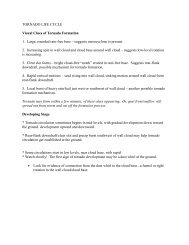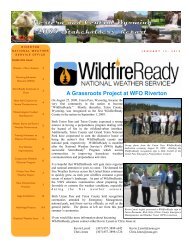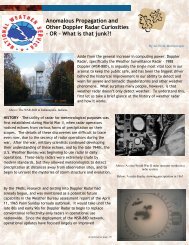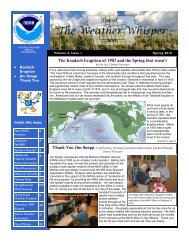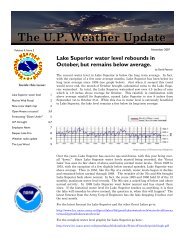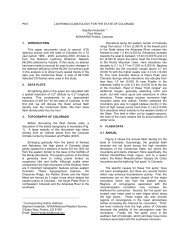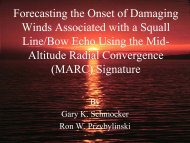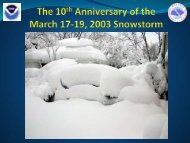Rainfall Totals from the Hermosa Flash Flood of 17 August 2007
Rainfall Totals from the Hermosa Flash Flood of 17 August 2007
Rainfall Totals from the Hermosa Flash Flood of 17 August 2007
Create successful ePaper yourself
Turn your PDF publications into a flip-book with our unique Google optimized e-Paper software.
Table 1 is a listing <strong>of</strong> <strong>the</strong> data that were collected through <strong>the</strong> cooperative efforts <strong>of</strong> <strong>the</strong><br />
USGS, NWS, and <strong>the</strong> help <strong>of</strong> <strong>the</strong> general public. Most <strong>of</strong> <strong>the</strong> rain fell during a period <strong>from</strong> 5:30<br />
pm to 8:30 pm (MDT).<br />
3.3 Comparison <strong>of</strong> Radar Data with <strong>Rainfall</strong> Reports<br />
Comparing <strong>the</strong> isohyetal map with WSR-88D radar data, two conclusions can be made.<br />
First, <strong>the</strong> areal coverage <strong>of</strong> <strong>the</strong> WSR-88D radar-estimated precipitation was close to <strong>the</strong> isohyetal<br />
map created <strong>from</strong> observed rainfall reports. However, <strong>the</strong> major difference was in <strong>the</strong> rainfall<br />
totals as <strong>the</strong> storm total precipitation values produced by <strong>the</strong> radar using <strong>the</strong> convective Z-R<br />
relationship were grossly underestimated. Figure 25 shows <strong>the</strong> radar-estimated storm total<br />
precipitation with <strong>the</strong> isohyetal rainfall amounts as an overlay. Storm total radar precipitation<br />
estimates near <strong>Hermosa</strong> use a 1 km by 2 km grid system. The large grid size combined with an<br />
averaging algorithm over <strong>the</strong> radar bin is most likely responsible for <strong>the</strong> underestimation <strong>of</strong> <strong>the</strong><br />
rainfall.<br />
4. Comparison to O<strong>the</strong>r Heavy Rain Events<br />
Storms <strong>of</strong> this nature are not unheard <strong>of</strong> in <strong>the</strong> Black Hills area <strong>of</strong> western South Dakota.<br />
Several storms producing rainfall in excess <strong>of</strong> 6 inches have occurred in recent history including<br />
<strong>the</strong> following: 14 June 1996 where 14.6 inches <strong>of</strong> rain fell near Piedmont, South Dakota; 7<br />
<strong>August</strong> 1999 in which 7 inches <strong>of</strong> rain fell near Custer, South Dakota; and 5 May <strong>2007</strong> where<br />
more than 6 inches <strong>of</strong> rain fell over <strong>the</strong> Badlands National Park.<br />
One may draw comparisons to <strong>the</strong> 9 June 1972 flood <strong>of</strong> Rapid Creek in Rapid City, South<br />
Dakota in which almost 15 inches <strong>of</strong> rain fell northwest <strong>of</strong> town causing Canyon Lake Dam to<br />
fail and 238 people to lose <strong>the</strong>ir lives. This event had some similar features including <strong>the</strong><br />
placement <strong>of</strong> a surface low across eastern Wyoming and a stationary front draped across western<br />
South Dakota. Some <strong>of</strong> <strong>the</strong> differences between <strong>the</strong>se two events include <strong>the</strong> placement <strong>of</strong> <strong>the</strong><br />
upper-level ridge far<strong>the</strong>r east in 1972, much lighter winds al<strong>of</strong>t in 1972, an easterly orographic<br />
lift component more prominent in 1972, and, in conjunction with <strong>the</strong>se, <strong>the</strong> duration and areal<br />
extent <strong>of</strong> <strong>the</strong> heavy rainfall was much larger in 1972 with more than 6 inches <strong>of</strong> rain falling over<br />
a 300 mi 2 area versus a 20 mi 2 area in <strong>2007</strong> west <strong>of</strong> <strong>Hermosa</strong>. Much more detailed information<br />
concerning <strong>the</strong> 9 June 1972 flood can be found in Schwarz et al. (1975).<br />
5. Chronology <strong>of</strong> NWS Products<br />
Table 2 lists <strong>the</strong> products issued by <strong>the</strong> National Wea<strong>the</strong>r Service in Rapid City, South<br />
Dakota, concerning <strong>the</strong> flood potential and ongoing flood concerns for <strong>the</strong> night <strong>of</strong> <strong>17</strong> <strong>August</strong><br />
<strong>2007</strong>. Over 48 hours before <strong>the</strong> flash flood and continuing through Friday, heavy rainfall was<br />
highlighted as a possibility in <strong>the</strong> hazardous wea<strong>the</strong>r outlook. A flash flood warning was issued<br />
for central Pennington County and nor<strong>the</strong>astern Custer County 11 minutes before any reports <strong>of</strong><br />
flash flooding occurred. A flash flood statement and a local storm report were issued during <strong>the</strong><br />
event relaying reports <strong>from</strong> law enforcement. In all <strong>the</strong> statements issued by <strong>the</strong> National<br />
Wea<strong>the</strong>r Service, <strong>Hermosa</strong> was included in <strong>the</strong> list <strong>of</strong> impacted locations.<br />
4




